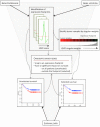Identifying driver genes in cancer by triangulating gene expression, gene location, and survival data
- PMID: 25949096
- PMCID: PMC4354331
- DOI: 10.4137/CIN.S18302
Identifying driver genes in cancer by triangulating gene expression, gene location, and survival data
Abstract
Driver genes are directly responsible for oncogenesis and identifying them is essential in order to fully understand the mechanisms of cancer. However, it is difficult to delineate them from the larger pool of genes that are deregulated in cancer (ie, passenger genes). In order to address this problem, we developed an approach called TRIAngulating Gene Expression (TRIAGE through clinico-genomic intersects). Here, we present a refinement of this approach incorporating a new scoring methodology to identify putative driver genes that are deregulated in cancer. TRIAGE triangulates - or integrates - three levels of information: gene expression, gene location, and patient survival. First, TRIAGE identifies regions of deregulated expression (ie, expression footprints) by deriving a newly established measure called the Local Singular Value Decomposition (LSVD) score for each locus. Driver genes are then distinguished from passenger genes using dual survival analyses. Incorporating measurements of gene expression and weighting them according to the LSVD weight of each tumor, these analyses are performed using the genes located in significant expression footprints. Here, we first use simulated data to characterize the newly established LSVD score. We then present the results of our application of this refined version of TRIAGE to gene expression data from five cancer types. This refined version of TRIAGE not only allowed us to identify known prominent driver genes, such as MMP1, IL8, and COL1A2, but it also led us to identify several novel ones. These results illustrate that TRIAGE complements existing tools, allows for the identification of genes that drive cancer and could perhaps elucidate potential future targets of novel anticancer therapeutics.
Keywords: cancer; data mining; driver genes; gene expression; survival.
Figures






Similar articles
-
Identifying driver genes involving gene dysregulated expression, tissue-specific expression and gene-gene network.BMC Med Genomics. 2019 Dec 30;12(Suppl 7):168. doi: 10.1186/s12920-019-0619-z. BMC Med Genomics. 2019. PMID: 31888619 Free PMC article.
-
DriverSubNet: A Novel Algorithm for Identifying Cancer Driver Genes by Subnetwork Enrichment Analysis.Front Genet. 2021 Feb 19;11:607798. doi: 10.3389/fgene.2020.607798. eCollection 2020. Front Genet. 2021. PMID: 33679866 Free PMC article.
-
DEOD: uncovering dominant effects of cancer-driver genes based on a partial covariance selection method.Bioinformatics. 2015 Aug 1;31(15):2452-60. doi: 10.1093/bioinformatics/btv175. Epub 2015 Mar 26. Bioinformatics. 2015. PMID: 25819079
-
Identifying Cancer Driver Genes Using Replication-Incompetent Retroviral Vectors.Cancers (Basel). 2016 Oct 25;8(11):99. doi: 10.3390/cancers8110099. Cancers (Basel). 2016. PMID: 27792127 Free PMC article. Review.
-
CRAC channels, calcium, and cancer in light of the driver and passenger concept.Biochim Biophys Acta. 2016 Jun;1863(6 Pt B):1408-17. doi: 10.1016/j.bbamcr.2015.12.009. Epub 2015 Dec 17. Biochim Biophys Acta. 2016. PMID: 26705695 Review.
References
Publication types
Grants and funding
LinkOut - more resources
Full Text Sources
Other Literature Sources
Miscellaneous

